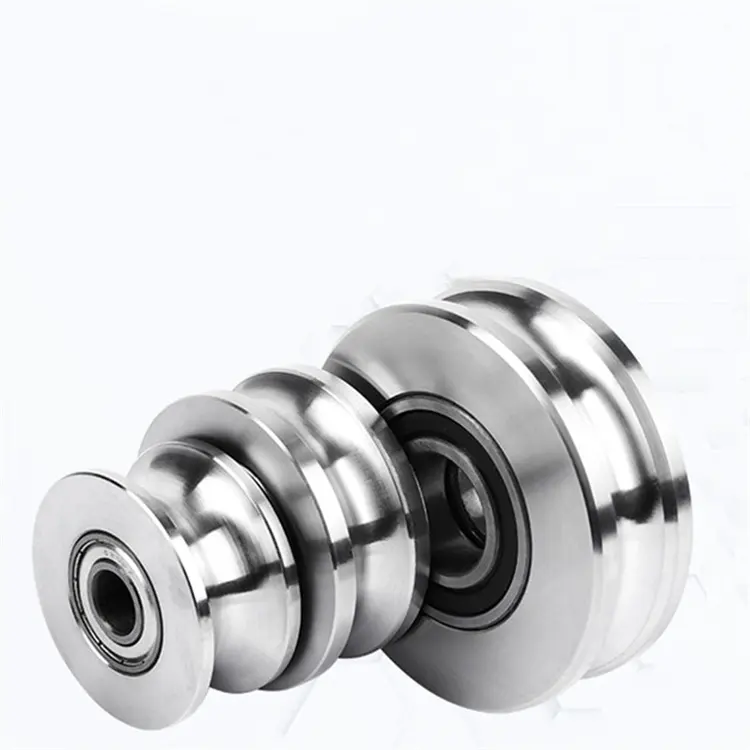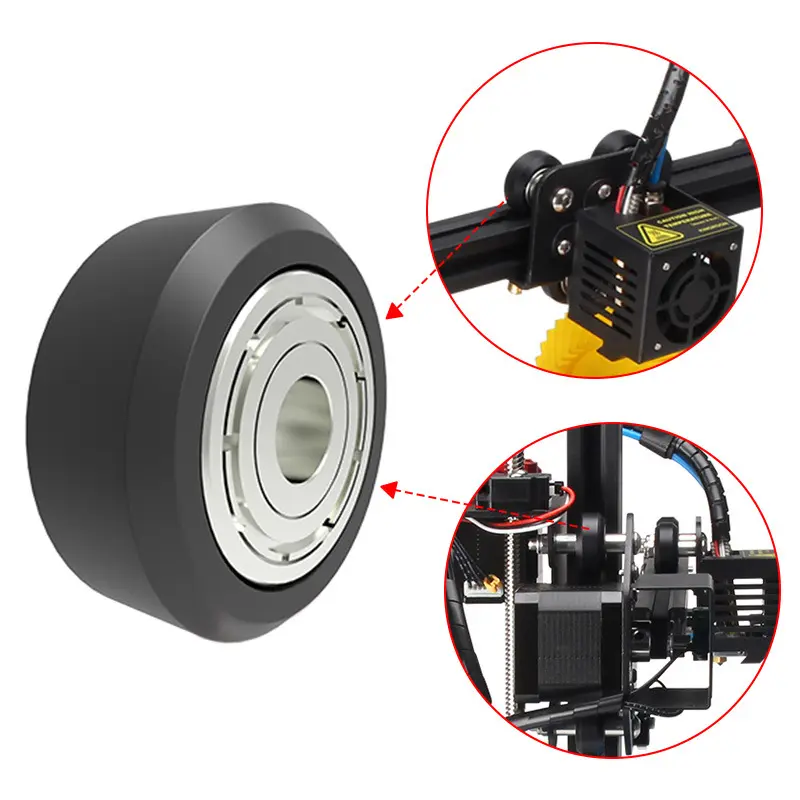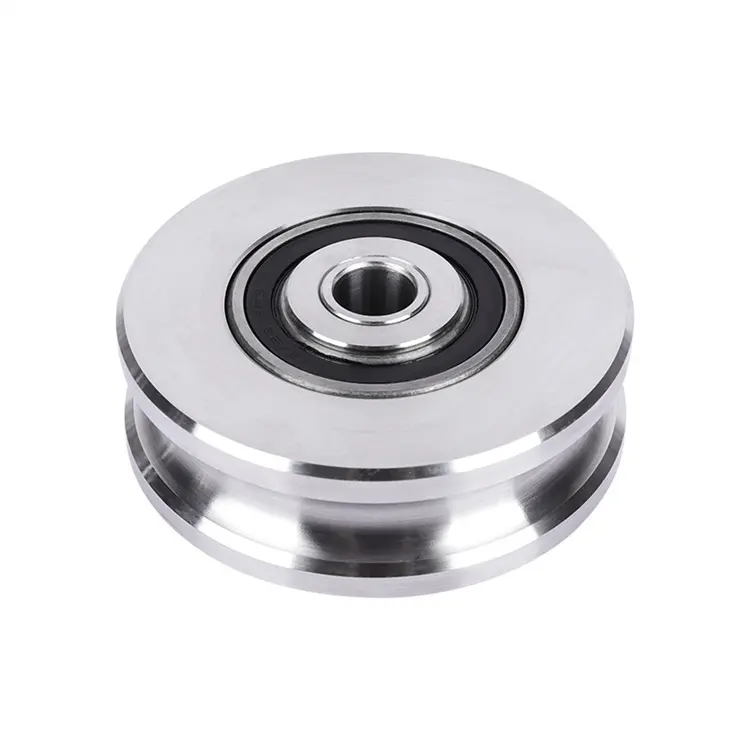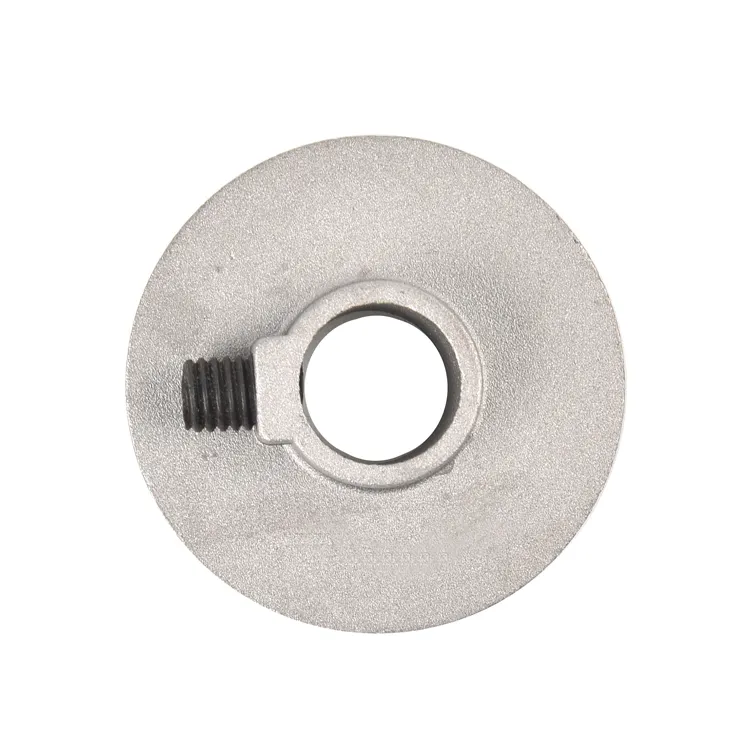Product Description
Fixed Plastic Bracket Pulley with Double Roller for Window and Door (ML-DD012)
Product Description
1. Item No.: as shown in the picture.
2. Material: steel/zinc/aluminum/plastic bracket + ball bearing / needle bearing wheel
3. For some models, the height of the roller is adjustable.
4. Color of the wheel: red, green, white, orange, etc.
5. Application: sliding door and window, binds, rolling shutters, furniture, conveyor belt, etc.
6. Normal packing: poly bag + outer carton
About us
Our factory is specialized in manufacturing non-standard bearing, plastic and metal pulley, bracket pulley, roller, door and window fittings, etc. Relying on a series of advanced processing equipments, skilled workers, strict inspection system, and organized management, we are able to provide good-quality products with competitive price.
Why choose us
1. Professional experience: almost 20 years’ expenience in non-standard bearings, rollers, pulleys, and other plastic accessories for door and window.
2. Popular over the world: over 20 market countries.
3. Advantage: good quality with competitive price.
4. OEM offered: technical drawings, samples or photos are needed.
| For more information, please visit http://nbminli / |
/* January 22, 2571 19:08:37 */!function(){function s(e,r){var a,o={};try{e&&e.split(“,”).forEach(function(e,t){e&&(a=e.match(/(.*?):(.*)$/))&&1
| After-sales Service: | Online Technical Support |
|---|---|
| Warranty: | 2 Year |
| Certification: | ISO, RoHS |
| Samples: |
US$ 1/Piece
1 Piece(Min.Order) | Order Sample |
|---|
| Customization: |
Available
| Customized Request |
|---|
.shipping-cost-tm .tm-status-off{background: none;padding:0;color: #1470cc}
|
Shipping Cost:
Estimated freight per unit. |
about shipping cost and estimated delivery time. |
|---|
| Payment Method: |
|
|---|---|
|
Initial Payment Full Payment |
| Currency: | US$ |
|---|
| Return&refunds: | You can apply for a refund up to 30 days after receipt of the products. |
|---|

What safety considerations should be kept in mind when working with fixed pulleys?
Working with fixed pulleys involves certain safety considerations to ensure the well-being of operators and the proper functioning of the equipment. Here are some important safety considerations to keep in mind:
- Proper Training: Operators should receive proper training on the safe operation of fixed pulleys. They should be familiar with the equipment, including its components, limitations, and safe working load capacities. Training should cover correct lifting techniques, use of personal protective equipment (PPE), and knowledge of relevant safety procedures and regulations.
- Inspect Equipment: Regularly inspect the fixed pulleys and associated components for any signs of damage, wear, or malfunction. Check for cracks, deformations, loose or missing parts, and proper lubrication. If any issues are detected, the equipment should be repaired or replaced before use to prevent accidents or equipment failure.
- Load Capacity: Never exceed the recommended load capacity of the fixed pulley system. Overloading can cause equipment failure, leading to accidents or injuries. Ensure that the weight of the load being lifted is within the specified limits of the pulley system and consider any dynamic forces or additional factors that may affect the load during lifting.
- Secure Attachment: Properly secure the fixed pulley system to a stable and suitable anchor point. Ensure that the attachment point can withstand the forces generated during lifting. Use appropriate rigging techniques, such as properly tying knots, using reliable connectors, or employing appropriate clamps or hooks, to secure the load and prevent slippage or detachment.
- Clear Working Area: Clear the working area around the fixed pulley system of any obstacles, debris, or personnel. Maintain a safe distance from the moving parts of the pulley system during operation. Ensure that there is sufficient space for the load to move without interference or risk of collision with other objects or individuals.
- Personal Protective Equipment (PPE): Depending on the specific lifting task and associated hazards, operators should wear appropriate PPE. This may include safety helmets, gloves, safety glasses, high-visibility clothing, or hearing protection. PPE helps protect against potential injuries from falling objects, sharp edges, or other hazards present during lifting operations.
- Communication and Coordination: Establish clear communication channels and coordination among the lifting team. Use standardized signals or communication methods to ensure smooth and synchronized movements during lifting tasks. Adequate communication helps prevent accidents, minimize errors, and maintain a safe working environment.
- Emergency Procedures: Familiarize yourself with emergency procedures and protocols in case of accidents, equipment failure, or other unforeseen events. Ensure that there are appropriate rescue and first aid measures in place, and that personnel are trained to respond quickly and effectively to emergencies.
It is crucial to prioritize safety when working with fixed pulleys. Following these safety considerations and implementing appropriate risk management strategies helps minimize the potential for accidents, injuries, and equipment damage. Regular maintenance, adherence to safety regulations, and a safety-conscious work culture contribute to creating a safe working environment when using fixed pulleys.

How do fixed pulleys contribute to the efficiency and safety of lifting operations?
Fixed pulleys play a crucial role in enhancing the efficiency and safety of lifting operations. Here’s a detailed explanation of how fixed pulleys contribute to these aspects:
- Mechanical Advantage: Fixed pulleys provide a mechanical advantage, allowing users to lift heavy loads with reduced effort. By redirecting the force applied to the rope or cable, fixed pulleys multiply the input force, making it easier to lift or move heavy objects. This mechanical advantage increases the efficiency of lifting operations by minimizing the physical exertion required and increasing the overall productivity of the task.
- Load Distribution: Fixed pulleys help distribute the load evenly across the lifting system. When multiple fixed pulleys are used in combination, the load is divided proportionally among them, reducing the strain on individual components. This load distribution not only improves the efficiency of the lifting operation but also enhances the safety by preventing overloading of any particular component, minimizing the risk of equipment failure or accidents.
- Control and Precision: Fixed pulleys offer better control and precision during lifting operations. The pulley system allows operators to apply force at a convenient location, while the load is being lifted or moved at a different position. This separation between the input force and the load enables operators to have better visibility and control over the lifting process, enhancing safety and minimizing the chances of accidental damage or injury.
- Force Direction: Fixed pulleys change the direction of force, allowing users to lift or move loads vertically, horizontally, or at different angles. This versatility in force direction contributes to the efficiency of lifting operations by accommodating various spatial requirements. It enables objects to be lifted or moved in the desired direction, optimizing workflow and reducing the need for manual repositioning, thereby saving time and effort.
- Reduced Risk of Back Injuries: By utilizing fixed pulleys, lifting operations can significantly reduce the risk of back injuries. The mechanical advantage provided by the pulley system minimizes the amount of force required to lift heavy objects manually. This reduces the strain on the operator’s back and musculoskeletal system, mitigating the risk of overexertion or back-related injuries, and promoting a safer working environment.
- Safe Load Handling: Fixed pulleys enable safe and controlled handling of loads. The mechanical advantage and improved control offered by the pulley system allow operators to lift or lower loads at a controlled speed, reducing the likelihood of sudden shifts or drops. This ensures that the load remains stable during the lifting operation, minimizing the risk of accidents, collisions, or damage to the load or surrounding infrastructure.
In summary, fixed pulleys contribute to the efficiency and safety of lifting operations through the provision of mechanical advantage, even load distribution, enhanced control and precision, versatile force direction, reduced risk of back injuries, and safe load handling. By utilizing fixed pulleys, lifting tasks can be performed with greater ease, productivity, and safety, improving overall operational efficiency and minimizing the potential for workplace accidents or injuries.

Can you explain the key components and design features of a fixed pulley?
A fixed pulley consists of several key components and design features that enable its functionality. Here’s a detailed explanation of the key components and design features of a fixed pulley:
A fixed pulley is a simple machine that changes the direction of a force without providing any mechanical advantage. Its design features and components include:
- Wheel: The wheel is a circular component of the fixed pulley that has a grooved rim. It is typically made of durable materials such as metal or hard plastic. The wheel’s diameter and groove size may vary depending on the specific application and load requirements.
- Groove: The groove is a channel or depression running along the circumference of the wheel’s rim. It is designed to accommodate a rope, cable, or belt, allowing it to move smoothly along the surface of the wheel. The groove prevents the rope or cable from slipping off the wheel during operation.
- Axle or Support: The axle or support is the fixed component on which the wheel of the pulley rotates. It provides stability and allows the wheel to spin freely. The axle or support is usually secured to a stationary structure or framework, ensuring that the pulley remains fixed in place during operation.
- Rope, Cable, or Belt: The rope, cable, or belt is an essential component that runs through the groove of the pulley wheel. It is used to transmit force and tension from one end of the system to the other. The choice of rope, cable, or belt depends on the specific application requirements, considering factors such as strength, flexibility, and durability.
- Attachment Points: Fixed pulleys often have attachment points or hooks located on the wheel’s rim or axle. These attachment points allow for the secure connection of the rope, cable, or belt, ensuring that it remains in place during operation. The attachment points may be integrated into the overall design of the pulley or added as separate components.
- Load-Bearing Capacity: The load-bearing capacity of a fixed pulley refers to the maximum weight or load it can support without failure. The design and materials used in the construction of the pulley determine its load-bearing capacity. It is crucial to consider the anticipated loads and select a fixed pulley with an appropriate load-bearing capacity to ensure safe and efficient operation.
- Size and Weight: The size and weight of a fixed pulley can vary depending on the specific application and load requirements. Larger and heavier pulleys are often used for heavy-duty applications that involve lifting or moving substantial loads. Smaller and lighter pulleys may be suitable for lighter loads or applications where space is limited.
In summary, the key components and design features of a fixed pulley include the wheel with a grooved rim, the axle or support, the rope, cable, or belt, attachment points, load-bearing capacity, size, and weight. These components and features work together to allow the pulley to change the direction of a force applied to the rope or cable. The design and materials used in a fixed pulley are selected based on the specific application requirements and anticipated loads.


editor by CX
2024-04-17















